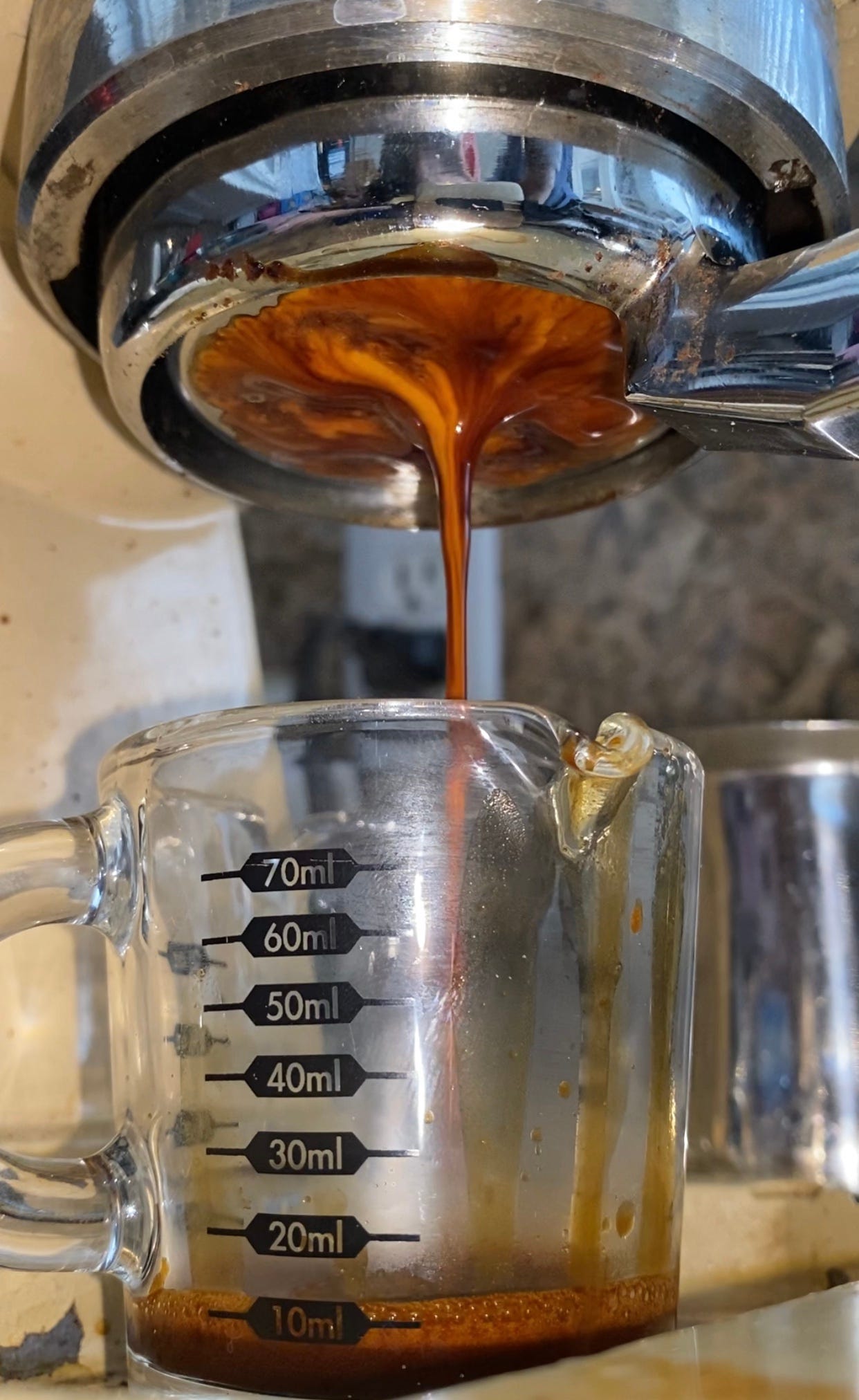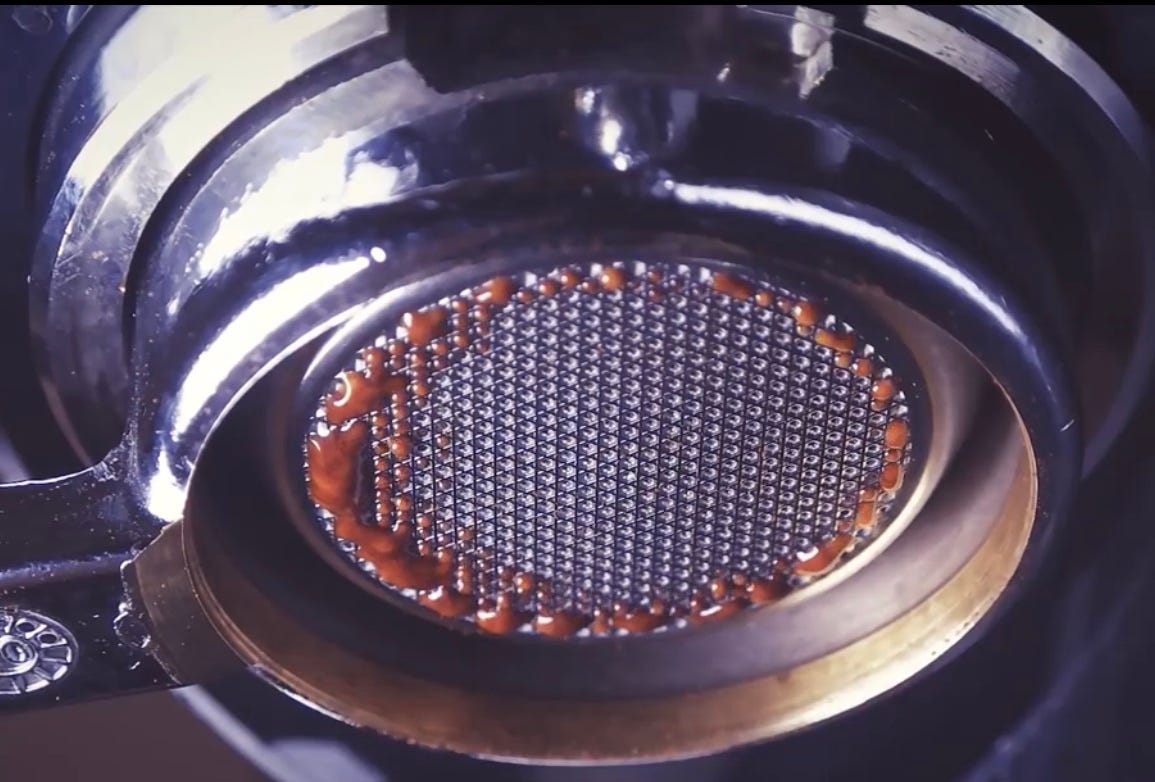Espresso Machine Donuts: Deeper Analysis into Extraction
The story of how I found an undesired donut in my espresso machine.
Espresso can easily become a rabbit hole that’s easy to dive down into. I discovered a phenomenon that is in the E61 grouphead as well as many other group heads (lever machines in particular), but to get there took a long road. Ultimately, I found the design of the shower head to cause an inherent uneven flow that has a greater effect on pre-infusion. Once I discovered the donut, I could easily spot the symptoms even in other people’s espresso videos. This is the story of the donut, and how many machines cause a donut shaped extraction because of their shower head.

Over a year ago, I decided to apply my day job skills to espresso, namely computer vision and data science. I did an analysis on espresso filters, started regularly recording my shots, and started a data sheet. These three things all influenced my theory on the donuts in the machine.

A bottomless portafilter really improved my shot, and I found myself using my phone to record shots for pleasure. However, I slowly started to see that those videos could give me more insight into my shot preparation. As a result, I bought a distributor and a leveler, and a later developed a technique to distribute using a paper clip. That technique was required for staccato espresso preparation as a toothpick wasn’t giving me consistency. After a few months, I was recording every shot as a way to view the shot live, review for timings, and explore for failure analysis. Few videos results in major changes but the culmination has transformed my shot skill.

For the espresso filters, I discovered that while VST filters are very well spec’ed, the distribution of hole size is not random; there were clumps of larger or smaller holes. I started to pay a lot more attention to the bottom of the filter during the shot, and my videos seemed to show the same repeated patterns for the same filter across different shots.
At the beginning of 2019, I decided to step into data recording for my shots. It took me time to figure out what was valuable to record, and it has been instrumental in developing my skill and the staccato espresso technique. I also have enjoyed the data collection and analysis as it’s my personal data set to collect, curate, and analyze.
Along my journey of experimenting, I found pressure pulsing provided better taste and extraction. However, I also started paying more attention to the shot extraction visually. I started to record pre-infusion, bloom, and infusion timings. Previously, I had adjusted by eye and counted in my head. Now, I used the video for more extract timing. I aimed for 20s, 10s, and 15s. 15/15/15 also worked well.
Additionally, I started to record a short description of the shot: centered, eccentric, one sided, donut, tiny donut, or uneven. The metric is somewhat subjective, but by trying to define one, I looked at the shot differently.








The first thing a critic will say from these images is that it looks like I have a bunch of bad shots and don’t know how to pull a shot. Pulling a manual shot can be tricky, but the only way to make improvements is an honest view of what the shots look like. Some of these were really great shots with interesting filter patterns because they were staccato shots. It should also be noted that if you watch your shots enough, you might just find they only appear to be great, but they still have room for improvement.

I noticed a lot of donuts or tiny donuts, and I initially thought I needed to improve my distribution technique. I got it to be very consistent, but it seemed to make the donuts more noticeable. Usually, the donut would appear during pre-infusion, and I could see it while pressure pulsing. The center of the filter didn’t have much coffee coming out or the coffee from the outer ring would converge in the center, obscuring the middle.
So I investigated further. I designed an experiment to help determine where across the filter the coffee was coming from as well as how much was extracted. The initial finding was that a larger volume of liquid didn’t necessarily mean a higher amount of coffee extracted. I designed an additional experiment with a higher resolution as well, and the results showed the outer ring had the higher amount of extraction even though the volume was about the same across the filter.
I also started looking at the shower screen, and I thought maybe my shower screen needed to be replaced. It’s the original screen, and it is just a wire mesh. In a slow motion video, I was able to verify that at lower pressures, the water comes out mostly even across the shower, but at higher pressures, the outer ring has a head start.






While I was frustrated by this water pattern, the manual machine was designed that way with three holes evenly spaced from the boiler to the piston. This is the same for most lever machines with a boiler attached. Did this phenomenon occur with other machines?




Now that I knew the pattern of the donut, I started looking through other people’s shot videos (for example: https://youtu.be/zF09mVAdTTU). Most of them showed this donut pattern at the beginning. For machines without pre-infusion, this pattern was only briefly there, and if there was a continued donut pattern, it would be difficult to notice due to the outer streams converging. Typically, this was chalked up to the metal edge of the filter not the water flow.




Another example:



Final Example:




Shower Head Design
This problem is unavoidable for a lever machine, but any machine that is similar to an E61 grouphead, could be better designed.
For lever machines, as the piston goes up, a few holes on the side let in water. This sprays to the edges and doesn’t do well to cover the middle. I looked at this effect without the shower screen is shown below.



So I replaced the shower screen with an IMS precision shower screen. I only cleaned it when I did a lengthy machine cleaning a year prior.

A quick check at the hole size variation, and it looks like we are in good shape. There are some variations across the filter, but nothing too terrible. Clearly there is one spot with more blue, so smaller holes. Then another spot with a lot of yellow, so larger holes. It’s possible this causes an initial unevenness, but I don’t have any data to support such a thesis.

The shower flow got a lot better which helped remove that variable in my shot process.




E61 Grouphead
This donut problem is not just a problem for lever machines. Most machines have a water distribution system that pushes the water to the edge of the piston causing water to start coming through the coffee on the edge just a little bit sooner than the rest of the puck. This causes a slight amount of channeling difficult to overcome or even notice due to the streams collecting in the center.

Here is a blown up diagram to show the water distributor.

The actual water distributor or sprinkler:

From the design, it doesn’t allow water to go straight to the center of the coffee puck. There are other designs, but this design has an inherent flaw similar to lever machines. This design is also very common across a variety of semi-automatic espresso machines.
To adjust for the donut, I’ve been doing longer pre-infusions (20 seconds). I’ve been able to more easily spot the donut or tiny donut when I pressure pulse, but it is also a sign I did my distribution correctly. My current experiments are using leveler alone to dial in what will cause the water to come through the puck more evenly. This donut behavior could be fixed on an E61 grouphead, but the mitigation for a lever seems more difficult.
I’m also more driven to buy a DE1 from Decent Espresso as their water distributor does not have this issue to this degree.
If you like, follow me on Twitter and YouTube where I post videos of espresso shots on different machines and espresso related stuff. You can also find me on LinkedIn.
Further readings of mine:
Staccato Espresso: Leveling Up Espresso
Measuring Espresso Extraction across the Filter
Coffee Solubility in Espresso: An Initial Study
Espresso Simulation: First Steps in Computer Models
The Tale of the Stolen Espresso Machine
Affordable Coffee Grinders: a Comparison








